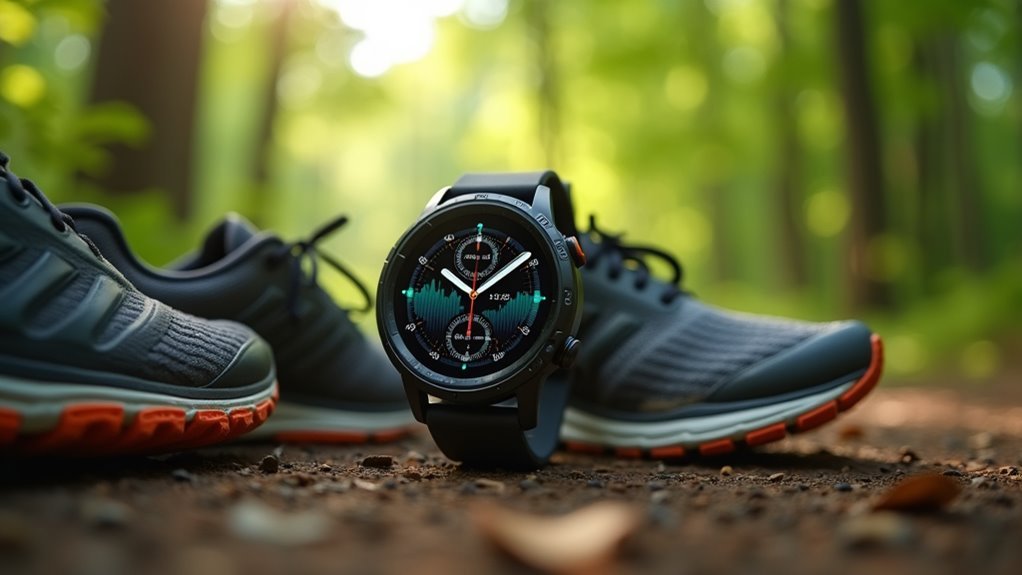You’ll maximize marathon performance by mastering five key heart rate zones: Zone 1 (50-60% MHR) for recovery and aerobic foundation, Zone 2 (60-70% MHR) for base building and fat utilization, Zone 3 (70-80% MHR) for tempo runs and lactate threshold development, and Zone 4 (80-90% MHR) for race-specific preparation. During your marathon, you’ll maintain 82-96% MHR, averaging around 88.7% throughout the race. Understanding these zones transforms your training from guesswork into precision coaching that’ll release your full potential.
Understanding the Five-Zone Heart Rate System for Marathon Training

When you’re training for a marathon, understanding heart rate zones becomes your roadmap to ideal performance and injury prevention.
The five-zone system operates on specific percentages of your maximum heart rate, each targeting unique physiological adaptations that’ll transform your running capabilities.
Zone 2 (60-70% MHR) builds your aerobic foundation through comfortable, conversational-pace runs.
Zone 3 (70-80% MHR) bridges easy and hard training with tempo efforts.
Zone 4 (80-90% MHR) develops lactate threshold through challenging intervals.
Zone 5 (90-100% MHR) maximizes speed and neuromuscular coordination.
For marathon success, you’ll spend 70-80% of your training time in lower-intensity zones, particularly Zone 2.
This distribution guarantees you’re building endurance without excessive fatigue while strategically incorporating higher-intensity work for speed development. Heart rate training provides actual effort insights versus perceived exertion, helping you recognize when your body needs additional recovery time.
Zone 1 Recovery Training: Building Your Aerobic Foundation at 50-60% MHR
Zone 1 training at 50-60% of your maximum heart rate forms the gentle foundation that supports your entire marathon training program. For someone with a 180 MHR, you’ll target 90-108 bpm during these sessions.
This zone’s primary purpose is recovery – it flushes out fatigue and reduces soreness after intense workouts while building your aerobic base.
You can accumulate high weekly mileage in Zone 1 without overwhelming your body. It’s particularly valuable for newer runners building endurance and confidence.
Use Zone 1 for warm-ups, cool-downs, and walking integration after runs. The training enhances fat utilization, improves cardiovascular efficiency, and reduces injury risk. During these sessions, your breathing should remain smooth and calm, allowing you to maintain a full conversation throughout the run.
Additionally, it provides mental recovery time and stress reduction, helping you develop a better mind-body connection while maintaining consistent training.
Zone 2 Base Building: Maximizing Fat Utilization at 60-70% MHR

Building upon your recovery foundation, Zone 2 training at 60-70% of maximum heart rate becomes the workhorse of your marathon preparation. This intensity transforms your body into a fat-burning machine while building essential aerobic capacity.
You’ll develop the metabolic efficiency needed to sustain 26.2 miles without hitting the wall.
Zone 2 training delivers three fundamental adaptations:
- Enhanced mitochondrial density – Your cellular powerhouses multiply and function more efficiently, improving energy production and lactate clearance.
- Increased capillary density – More blood vessels deliver oxygen to working muscles, supporting sustained performance.
- Optimized fat utilization – Your body learns to burn fat as primary fuel, conserving precious glycogen stores for race-day surges.
This training zone allows high volume without excessive fatigue, making it perfect for building your marathon base. Zone 2 training should comprise 60-75% of weekly running volume to ensure optimal aerobic development and endurance improvements.
Zone 3 Tempo Runs: Developing Lactate Threshold at 70-80% MHR
After establishing your aerobic foundation through Zone 2 work, Zone 3 tempo runs at 70-80% maximum heart rate push you into the “comfortably hard” domain where real marathon magic happens.
You’ll hover just below your lactate threshold, where your body learns to clear lactate efficiently while maintaining sustained effort.
These sessions develop vital race-specific adaptations: enhanced glycogen storage, improved running economy, and increased oxygen efficiency.
You’ll build mental toughness by practicing target race pace, developing confidence and pacing skills essential for marathon day.
Incorporate 1-2 tempo sessions weekly, ranging from 20-40 minutes at effort. At this intensity, your conversation becomes limited to two to three sentences as you maintain the proper effort level.
Progress gradually through your training cycle, balancing with adequate recovery.
Avoid excessive Zone 3 work—it’ll hinder performance gains and increase injury risk.
Zone 4 Threshold Training: Race-Specific Preparation at 80-90% MHR

When you’re ready to sharpen your marathon fitness, Zone 4 threshold training at 80-90% maximum heart rate becomes your secret weapon for race-specific preparation.
This high-intensity zone pushes your lactate threshold while remaining sustainable for limited periods, making it perfect for developing race pace and speed.
You’ll want Zone 4 workouts to comprise about 20% of your weekly volume, with the remaining 80% at lower intensities.
Train in bursts rather than prolonged efforts to maximize adaptation while preventing overtraining.
Smart Zone 4 training uses short, intense bursts to trigger powerful adaptations while keeping your body fresh and injury-free.
Effective Zone 4 workouts include:
- Tempo intervals: 3-8 minute repeats at threshold pace with equal recovery
- Hill repeats: High-intensity uphill sprints targeting strength and power
- Progression runs: Gradually accelerating to Zone 4 toward the finish
You’ll enhance lactate buffering, improve metabolic flexibility, and build mental toughness essential for marathon success. Regular threshold training builds tolerance at this intensity, allowing you to maintain faster paces without crossing into the anaerobic zone where rapid exhaustion occurs.
Determining Your Maximum Heart Rate for Accurate Zone Calculations
The foundation of effective heart rate zone training rests on one critical measurement: your maximum heart rate (MHR).
You’ll likely use the simple 220 minus your age formula, which gives a 30-year-old runner an estimated 190 bpm. However, the Tanaka formula (208 minus 0.7 times your age) provides better accuracy, especially if you’re older.
While laboratory testing offers the most precise results through supervised treadmill or cycling tests, it’s expensive and impractical for most runners.
Remember that formula estimates can vary by 10-15 bpm from your actual MHR due to genetics, fitness level, and health factors. Medications like beta-blockers also affect these calculations. For the most accurate personal estimation, consider conducting a field test where you warm up properly and exercise to near maximum effort with a training partner for safety.
Use formulas cautiously and consult professionals if you have cardiovascular concerns.
Race Day Heart Rate Strategy: Sustaining 82-96% MHR for 26.2 Miles
Now that you’ve established your maximum heart rate, you’ll need to apply this knowledge strategically across 26.2 miles of racing. Marathon runners typically sustain 82-96% of their maximum heart rate throughout the race, with the average settling around 88.7% MHR. This intensity places most of your effort in Zone 4, demanding exceptional aerobic fitness and careful pacing.
Marathon success hinges on strategically managing 88.7% maximum heart rate across 26.2 miles while maintaining Zone 4 intensity through exceptional pacing discipline.
Your race day heart rate strategy should follow these principles:
- Start conservatively at 82-85% MHR to preserve energy for later miles.
- Accept gradual drift as dehydration and glycogen depletion naturally increase your heart rate.
- Save Zone 5 efforts (94-100% MHR) for the final push when you can afford to empty the tank.
Monitor for warning signs like sudden spikes, dizziness, or chest pain that indicate overexertion. Environmental factors such as high elevation and temperature can significantly impact your heart rate response during the race.
Frequently Asked Questions
How Do Altitude Changes Affect Heart Rate Zones During Marathon Training?
Altitude elevates your heart rate for any given pace due to reduced oxygen availability. You’ll need to recalibrate your training zones using perceived exertion since your usual heart rate targets won’t match performance levels.
Should I Adjust Heart Rate Zones Based on Hot Weather Conditions?
You should adjust heart rate zones for hot weather since heat elevates your heart rate at slower paces. Maintain target zones by reducing pace rather than forcing normal speeds at dangerously high heart rates.
Do Heart Rate Zones Change as I Age During Training Cycles?
Yes, you’ll need to adjust your heart rate zones as you age during training cycles. Your maximum heart rate decreases over time, lowering all zone thresholds and requiring longer warm-ups and recovery periods.
How Accurate Are Fitness Tracker Heart Rate Readings for Zone Training?
Fitness tracker heart rate readings aren’t very accurate for zone training. Wrist devices show poor correlation during activities, and formula-based zones are typically off by 4-6 beats per minute compared to targeted zones.
Can Medications Affect My Maximum Heart Rate and Zone Calculations?
Yes, medications like beta blockers markedly lower your maximum heart rate and reduce heart rate reserve. You’ll need individualized testing rather than standard formulas, and should combine perceived exertion with heart rate monitoring.
In Summary
You’ll transform your marathon performance by mastering these heart rate zones through consistent training. Don’t rush the process—build your aerobic base in zones 1-2 before advancing to higher intensities. You’ve got the framework to train smarter, not just harder. Monitor your progress, adjust your zones as you improve, and trust the science behind heart rate training. Your disciplined approach to zone-based training will deliver the marathon breakthrough you’re seeking.





Leave a Reply